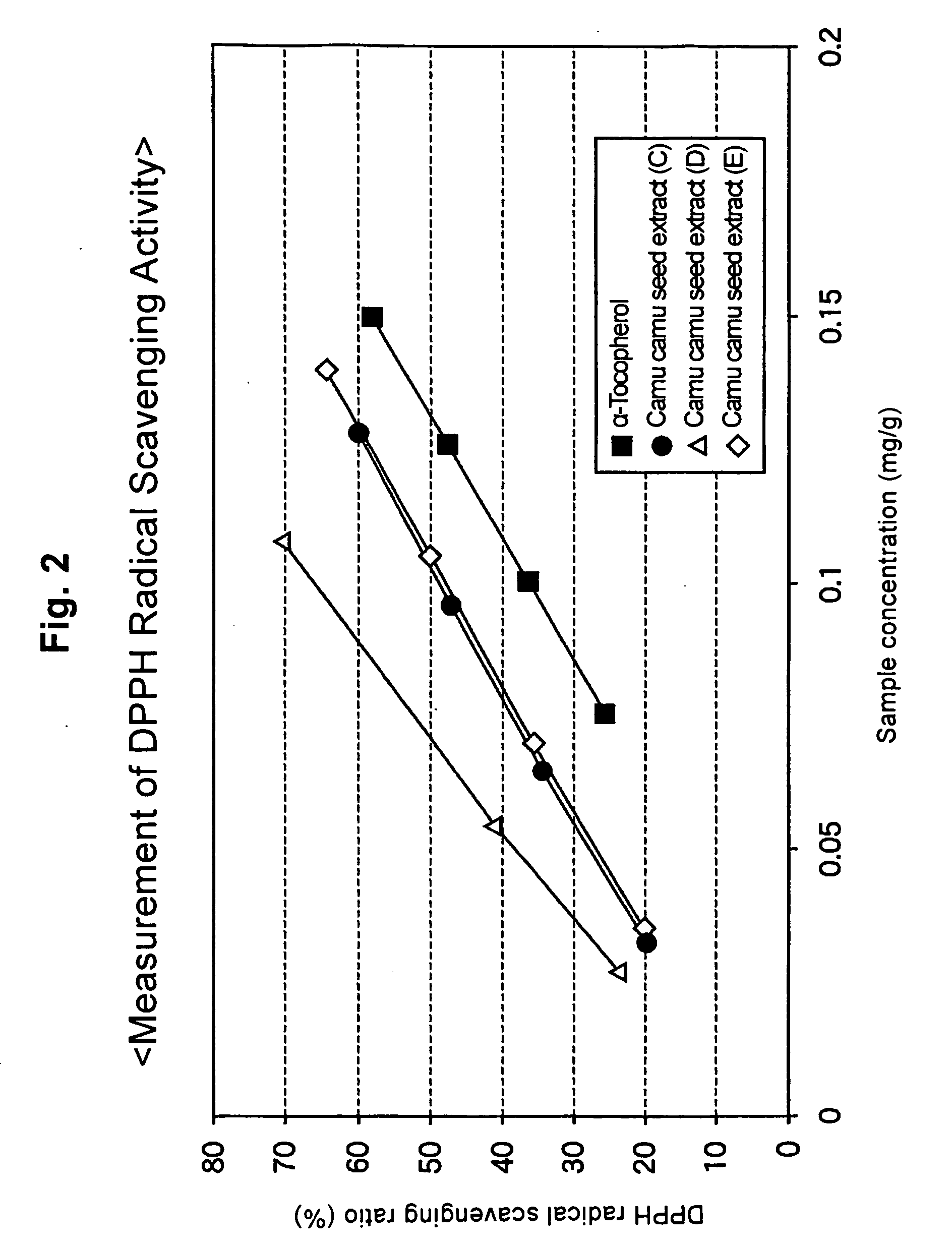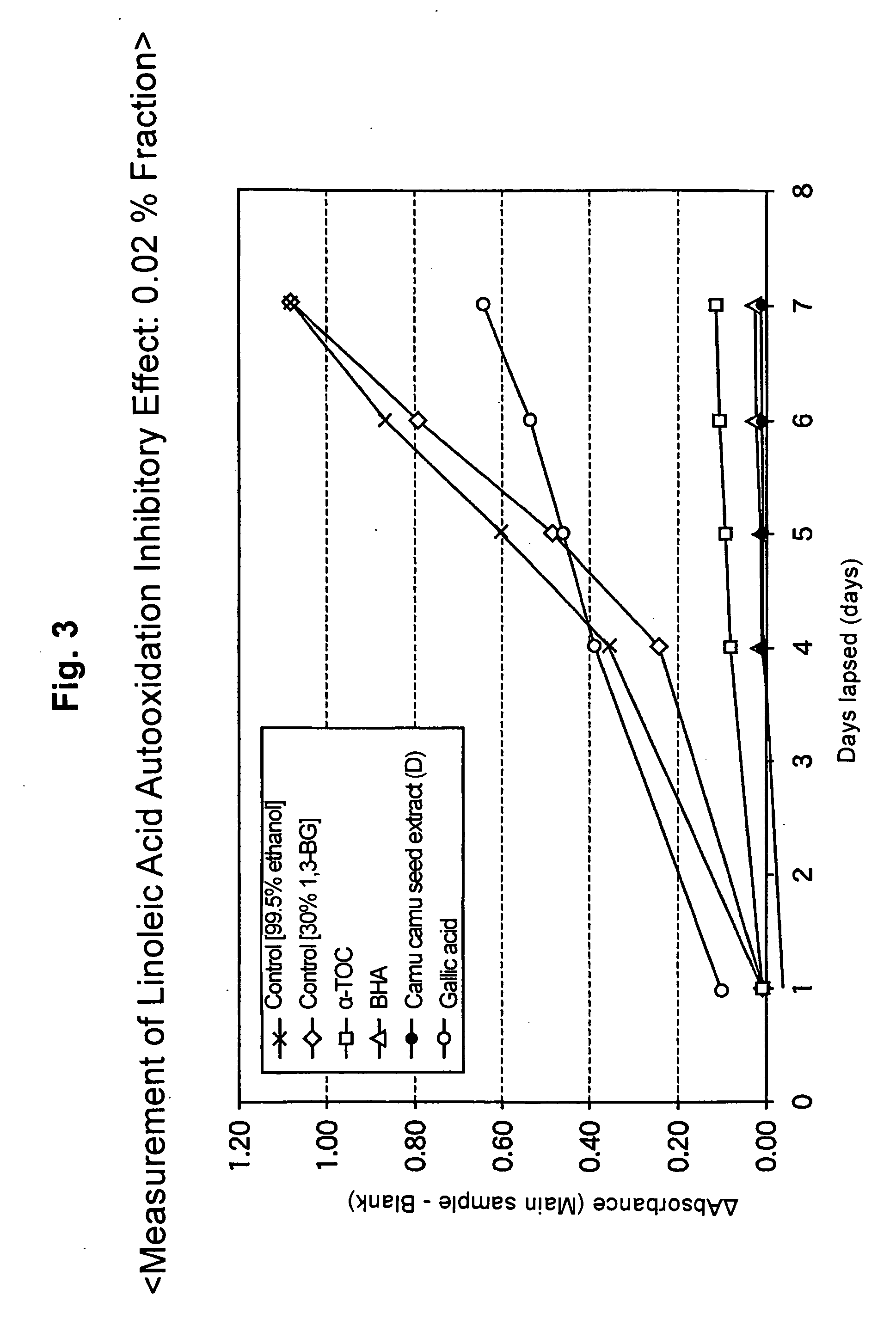Whitening agent, skin preparation for external use and cosmetic
a technology for skin preparation and whitening agent, applied in the field of whitening agent, can solve the problems of skin coloration, skin coloration acceleration, serious problems, etc., and achieve the effect of high safety and whitening
- Summary
- Abstract
- Description
- Claims
- Application Information
AI Technical Summary
Benefits of technology
Problems solved by technology
Method used
Image
Examples
referential example 1
[0047] Camu camu seeds were crushed, mixed with methanol, and stirred at 25° C. overnight for extraction. The mixture was centrifuged at 5° C. at 4000 rpm for 45 minutes, coasely filtered, and then passed through a 0.22 μm filter. The obtained methanol extract of camu camu seeds was vacuum distilled and evaporated to dry, and the resulting dry product was dissolved in purified water. To this solution, n-hexane was added, shaken for 5 minutes, and then left still, which operation was repeated until the n-hexane fraction was not colored, to thereby separate the water-soluble fraction from the n-hexane fraction. To the obtained water-soluble fraction, ethyl acetate was added, and fractionated in the same way as with n-hexane, to thereby separate the ethyl acetate fraction from the water-soluble fraction. The obtained ethyl acetate fraction was concentrated by vacuum distillation, and fractionated on a column of silica gel. The fractions were eluted in sequence with chloroform / methanol ...
referential example 2
[0056] 1 kg of camu camu seeds were crushed, mixed with 4 kg of water, and stirred at room temperature longer than overnight for extraction. After the stirring extraction, the mixture was centrifuged to separate the supernatant from the coarse residue, the residue was removed, and only the supernatant was collected. For further clarification, the supernatant was subjected to multi-stage filtration to remove fine residues. Through this operation, about 4 kg of a clear, water-soluble camu camu seed extract (1% solid) was obtained, and referred to as extract (C).
[0057] The obtained extract (C) was tested for the DPPH radical scavenging activity in the same way as in Referential Example 1. The same procedure was also performed with α-tocopherol, which is a known antioxidative component, for measuring the DPPH radical scavenging activity. The results are shown in FIG. 2. From FIG. 2, it is understood that the IC50 of extract (C) was 0.10 mg / g, whereas the IC50 of α-tocopherol was 0.13 m...
referential example 3
[0058] 1 kg of camu camu seeds were crushed, mixed with a mixed solvent of 1.17 kg of water and 0.5 kg of 1,3-butyleneglycol, and stirred at room temperature longer than overnight for extraction. After the stirring extraction, the mixture was centrifuged to separate the supernatant from the coarse residue, the residue was removed, and only the supernatant was collected. For further clarification, the supernatant was subjected to multi-stage filtration to remove fine residues. Through this operation, about 1.3 kg of 30% 1,3-butylene glycol extract of camu camu seeds (3% solid) was obtained, which was clear. This extract is referred to as extract (D).
[0059] The obtained extract (D) was tested for the DPPH radical scavenging activity in the same way as in Referential Example 1. The results are shown in FIG. 2. From FIG. 2, it is understood that the IC50 of extract (D) was 0.07 mg / g.
PUM
| Property | Measurement | Unit |
|---|---|---|
| diameter | aaaaa | aaaaa |
| diameter | aaaaa | aaaaa |
| temperature | aaaaa | aaaaa |
Abstract
Description
Claims
Application Information
 Login to View More
Login to View More - R&D
- Intellectual Property
- Life Sciences
- Materials
- Tech Scout
- Unparalleled Data Quality
- Higher Quality Content
- 60% Fewer Hallucinations
Browse by: Latest US Patents, China's latest patents, Technical Efficacy Thesaurus, Application Domain, Technology Topic, Popular Technical Reports.
© 2025 PatSnap. All rights reserved.Legal|Privacy policy|Modern Slavery Act Transparency Statement|Sitemap|About US| Contact US: help@patsnap.com



